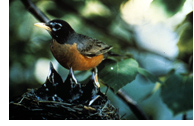
Hands-off Wildlife

Every year, Department of Natural Resources offices receive numerous calls about 'orphan' newborn wildlife that people have taken in as pets. Adopting wildlife as house pets is dangerous to the animal and rescuer, and is prohibited in Nova Scotia.
Expanding urban development means more housing is being built in traditional wildlife habitat. You must expect the presence of wildlife and learn to coexist, without interfering.
If an animal seems to be hurt, lost or abandoned, call your local Department of Natural Resources office.
Myth: “Ah, it’s so cute and helpless and it seems to be abandoned.”
Fact: In the spring, wildlife is in abundance in Nova Scotia’s woodlands. Wild animals like newborn deer, raccoons, skunk and birds are often seen to be cute and cuddly. However, looks can be deceiving. People have been injured by wildlife they have treated as pets.
![]()
 Myth: “I should leave some food out for the animals this time of year.”
Myth: “I should leave some food out for the animals this time of year.”
Fact: Animals are well adapted to finding food in the wild, and do not need supplemental foods from people. Feeding wildlife to attract them for viewing is common, but it is also the cause of the majority of nuisance wildlife problems. Remember, you may be feeding wildlife unintentionally by not storing garbage securely, leaving bird feeders out, neglecting to clean barbecues or littering.
Myth: “It will never survive on its own in the forest.”
Fact: Wild animals, even newborns, have a great ability to survive on their own. Young wildlife should be left alone, since they are usually not truly orphaned. A parent is often nearby or will return soon. Your presence could cause the parent to abandon the young, or to become aggressive and attack you. Any contact with wildlife can be risky, or even harmful, to you and the animal.
 Myth: “It’s a good deed to take this little creature in and give it a second chance.”
Myth: “It’s a good deed to take this little creature in and give it a second chance.”
Fact: Taking in a wild animal isn’t like adopting a puppy or kitten. Wild animals typically have special requirements for nutrition, shelter and space that which non-trained people cannot provide. Most ‘rescuers’eventually realize the problems in trying to domesticate it and decide they don't want the animal any longer.
Myth: “Wow, it would make a great pet. Way cooler than a dog.”
Fact: Young wildlife can grow up to be aggressive, especially when kept in captivity. Male fawns will eventually have antlers and may be easily agitated and attack during mating season. There is also the possibility of diseases, including mange, distemper, rabies, Lyme disease, and raccoon roundworm, which can be transferred to people or domestic pets.
 Myth: “There’s no harm in keeping a deer or a raccoon for a while. I can always turn it loose when it gets older.”
Myth: “There’s no harm in keeping a deer or a raccoon for a while. I can always turn it loose when it gets older.”
Fact: Creatures of the wild do not make good pets and captivity poses a constant stress to them. When raised without contact with their own species they fail to develop survival skills and fear of humans, virtually eliminating their chances of survival in the wild.
Myth: “There’s no law against taking in wildlife, is there?.”
Fact: Yes, there is a law against it. Raising or keeping wildlife is illegal under the Nova Scotia Wildlife Act.
Myth: “Well, if I can’t take in this animal, what can be done to save it?”
Fact: If an animal seems to be hurt, lost or abandoned, do not approach it. Observe its behaviour and then call your local Department of Natural Resources office. Wildlife specialists will help determine how best to help the animal.